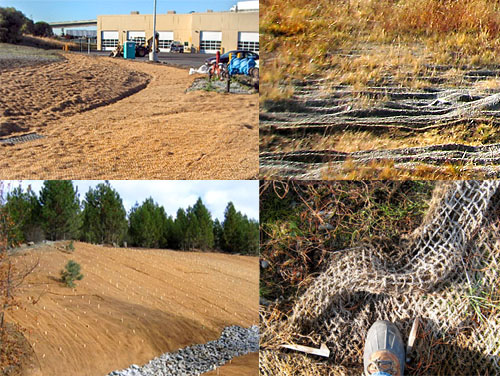Ideal Practices for Disintegration Control in Construction Projects
Are you dealing with a building and construction job and concerned regarding disintegration control? Look no further! In this write-up, we will lead you through the most effective techniques for stopping disintegration on your site. You'll discover 5 vital techniques, effective debris and runoff monitoring strategies, key factors to consider for incline stablizing, and ideas for protecting plant life and dirt. We'll additionally dig into the value of carrying out proper water drainage systems. Prepare yourself to take on erosion head-on and make sure the success of your building and construction task.
5 Crucial Disintegration Control Methods

To effectively manage erosion on your building site, you'll need to apply necessary strategies such as slope stablizing and debris control steps. Slope stablizing is critical in preventing soil erosion on steep slopes. One more efficient technique is the usage of erosion control blankets or floor coverings, which are positioned on the slope and aid preserve soil bits while allowing vegetation to expand.
Effective Sediment and Drainage Administration

You can efficiently manage debris and runoff in your building and construction task by applying proper erosion control measures. Debris and drainage administration is important to stop erosion and shield the surrounding environment. One reliable step is the installment of silt fences along the perimeter of the construction site. These fencings aid to have sediment and stop it from going into neighboring water bodies. An additional important practice is the implementation of disintegration control blankets or mats. These blankets offer a safety layer on bare dirt, lowering the influence of rains and protecting against disintegration. Additionally, the usage of debris containers or sediment catches can aid to capture debris and avoid it from entering stormwater systems. Routine upkeep of these measures is vital to guarantee their effectiveness throughout the building task. This includes inspecting and cleansing sediment basins and frequently changing silt fencings and disintegration control coverings as required. By implementing these erosion control steps, you can effectively manage sediment and runoff in your construction project, reducing the effect on the atmosphere and abiding by regulative requirements.
Key Considerations for Incline Stabilization
When taking into consideration incline stablizing, it is necessary to examine the surface and determine prospective locations of instability. You need to thoroughly examine the slope's qualities, such as its drain, make-up, and angle patterns. Search for indications of disintegration, such as subjected origins, splits, or down dirt. These indicators can give you an idea of where stablizing actions might be required.
Once you have identified the unsteady areas, you can start carrying out steps to maintain the slope. One common approach is using keeping walls or terracing to create a collection of flat steps, which can aid distribute the weight and prevent further disintegration. An additional option is to grow plants on the incline, as the origins can assist secure the dirt and control disintegration. Furthermore, mounting disintegration control coverings or floor coverings can supply instant defense while vegetation becomes recognized.
It's important to regularly keep track of the stabilized inclines to ensure their effectiveness. Watch out for any kind of indicators of motion or erosion, and take prompt activity if needed. Normal maintenance, such as examining and repairing any kind of damaged steps, is additionally important to ensure lasting stability.
Ideal Practices for Greenery and Dirt Security
One reliable means to secure greenery and dirt on inclines is by frequently checking for indications of disintegration and taking immediate action if necessary. Beginning by examining the slope for any indications of disintegration, such as revealed roots, bare dirt patches, or sediment accumulation at the base. Implement erosion control actions such as setting up erosion control blankets, mulching, or even constructing keeping wall surfaces if needed.
Carrying Out Appropriate Water Drainage Equipments
When it comes to handling water flow and stopping disintegration, recognizing these elements is essential. try this web-site Steeper slopes can lead to much faster water flow, increasing the threat of disintegration and flooding. On the other hand, gentler slopes allow water to flow a lot more gradually, minimizing erosion capacity.
Dirt type also influences drain system style. Various dirt kinds have differing degrees of permeability, affecting exactly how water is absorbed and drained. For example, sandy dirts often tend to drain faster because of their crude structure, while clay dirts have a slower water drainage price as a result of investigate this site their compact nature. Comprehending the dirt kind helps in selecting proper drain techniques, such as using absorptive materials or setting up French drains. In addition, considering the dirt characteristics helps protect against waterlogging, which can cause bad plant growth and damage to frameworks.
Final Thought
In verdict, when it comes to erosion control in construction tasks, you should follow these ideal methods. Think about slope stablizing approaches to ensure the security of the website. By adhering to these crucial methods, you can successfully manage disintegration and guarantee the success of your building and construction project.
To properly manage disintegration on your building site, you'll need to carry out essential techniques such as slope stablizing and debris control procedures. Slope stablizing is important in avoiding soil disintegration on steep slopes. Another efficient strategy is the straight from the source use of erosion control blankets or floor coverings, which are placed on the slope and help retain soil bits while enabling vegetation to expand. Another choice is to grow greenery on the slope, as the origins can help anchor the soil and control disintegration. Implement disintegration control procedures such as mounting erosion control blankets, mulching, or even creating preserving walls if required.